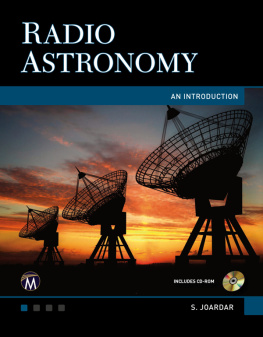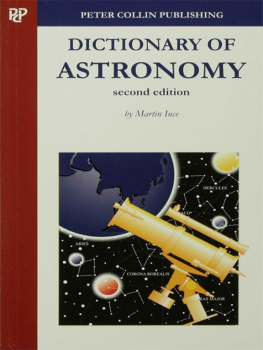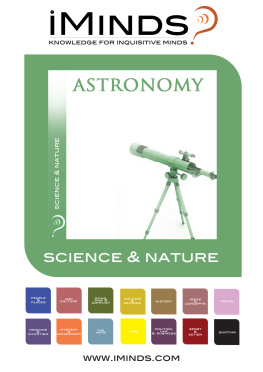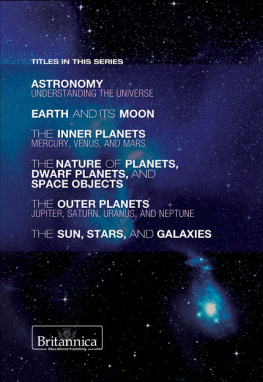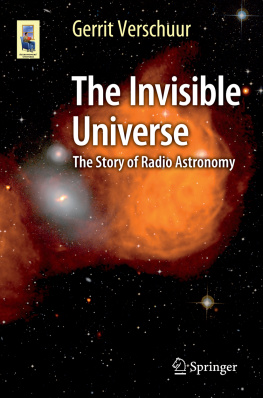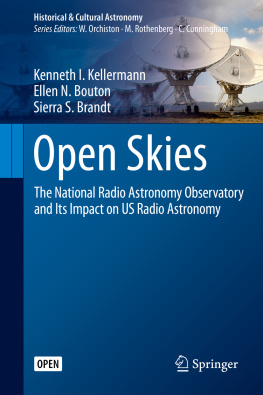Claycomb James R. - Radio astronomy
Here you can read online Claycomb James R. - Radio astronomy full text of the book (entire story) in english for free. Download pdf and epub, get meaning, cover and reviews about this ebook. year: 2016, publisher: Mercury Learning and Information, genre: Children. Description of the work, (preface) as well as reviews are available. Best literature library LitArk.com created for fans of good reading and offers a wide selection of genres:
Romance novel
Science fiction
Adventure
Detective
Science
History
Home and family
Prose
Art
Politics
Computer
Non-fiction
Religion
Business
Children
Humor
Choose a favorite category and find really read worthwhile books. Enjoy immersion in the world of imagination, feel the emotions of the characters or learn something new for yourself, make an fascinating discovery.
- Book:Radio astronomy
- Author:
- Publisher:Mercury Learning and Information
- Genre:
- Year:2016
- Rating:4 / 5
- Favourites:Add to favourites
- Your mark:
- 80
- 1
- 2
- 3
- 4
- 5
Radio astronomy: summary, description and annotation
We offer to read an annotation, description, summary or preface (depends on what the author of the book "Radio astronomy" wrote himself). If you haven't found the necessary information about the book — write in the comments, we will try to find it.
Radio astronomy — read online for free the complete book (whole text) full work
Below is the text of the book, divided by pages. System saving the place of the last page read, allows you to conveniently read the book "Radio astronomy" online for free, without having to search again every time where you left off. Put a bookmark, and you can go to the page where you finished reading at any time.
Font size:
Interval:
Bookmark:

LICENSE, DISCLAIMER OF LIABILITY, AND LIMITED WARRANTY
By purchasing or using this book (the Work), you agree that this license grants permission to use the contents contained herein, but does not give you the right of ownership to any of the textual content in the book or ownership to any of the information or products contained in it. This license does not permit uploading of the Work onto the Internet or on a network (of any kind) without the written consent of the Publisher. Duplication or dissemination of any text, code, simulations, images, etc. contained herein is limited to and subject to licensing terms for the respective products, and permission must be obtained from the Publisher or the owner of the content, etc., in order to reproduce or network any portion of the textual material (in any media) that is contained in the Work.
M ERCURY L EARNING A ND I NFORMATION LLC (MLI or the Publisher) and anyone involved in the creation, writing, or production of the companion disc, accompanying algorithms, code, or computer programs (the software), and any accompanying Web site or software of the Work, cannot and do not warrant the performance or results that might be obtained by using the contents of the Work. The author, developers, and the Publisher have used their best efforts to insure the accuracy and functionality of the textual material and/or programs contained in this package; we, however, make no warranty of any kind, express or implied, regarding the performance of these contents or programs. The Work is sold as is without warranty (except for defective materials used in manufacturing the book or due to faulty workmanship).
The author, developers, and the publisher of any accompanying content, and anyone involved in the composition, production, and manufacturing of this work will not be liable for damages of any kind arising out of the use of (or the inability to use) the algorithms, source code, computer programs, or textual material contained in this publication. This includes, but is not limited to, loss of revenue or profit, or other incidental, physical, or consequential damages arising out of the use of this Work.
The sole remedy in the event of a claim of any kind is expressly limited to replacement of the book, and only at the discretion of the Publisher. The use of implied warranty and certain exclusions vary from state to state, and might not apply to the purchaser of this product.

Copyright 2014 by M ERCURY L EARNING AND I NFORMATION LLC. All rights reserved.
Original title and copyright: Basic Techniques of Radio Astronomy. Copyright 2012 by Overseas Press India Pvt Ltd. All rights reserved.
This publication, portions of it, or any accompanying software may not be reproduced in any way, stored in a retrieval system of any type, or transmitted by any means, media, electronic display or mechanical display, including, but not limited to, photocopy, recording, Internet postings, or scanning, without prior permission in writing from the publisher.
Publisher: David Pallai
M ERCURY L EARNING AND I NFORMATION
22841 Quicksilver Drive
Dulles, VA 20166
info@merclearning.com
www.merclearning.com
1-800-758-3756
This book is printed on acid-free paper.
S. Joardar and J. R. Claycomb. Radio Astronomy.
ISBN:978-1-936420-35-3
The publisher recognizes and respects all marks used by companies, manufacturers, and developers as a means to distinguish their products. All brand names and product names mentioned in this book are trademarks or service marks of their respective companies. Any omission or misuse (of any kind) of service marks or trademarks, etc. is not an attempt to infringe on the property of others.
Library of Congress Control Number: 2013944480
141516321
Our titles are available for adoption, license, or bulk purchase by institutions, corporations, etc. For additional information, please contact the Customer Service Dept. at 1-800-758-3756 (toll free).
The sole obligation of M ERCURY L EARNING AND I NFORMATION to the purchaser is to replace the book and/or disc, based on defective materials or faulty workmanship, but not based on the operation or functionality of the product.
PREFACE
PREFACE TO THIS EDITION
This edition of Basic Techniques of Radio Astronomy has been supplemented with context-connection boxes, including NASAs Deep Space Network (DSN), the South Pole Telescope (SPT), the Low-Frequency Array (LOFAR), Space Very Long Baseline Interferometry (VLBI), pulsar dispersion and distance, and plane waves in conducting and dielectric media. Three appendices have been added on radiation potential formalism, the physics of radio spectral lines, and a table of world radio observatories. Several problems have been added to emphasize the physical aspects of radio astronomy. Supplementary materials and all textbook figures are included on the companion disc.
James R. Claycomb
Houston, TX
MARCH, 2014
PREFACE TO THE ORIGINAL EDITION
This book is based on my lectures on the subject of radio astronomy and techniques delivered at various places including the GMRT. It is designed from the point of view of a large audience consisting of persons who are associated with radio astronomy. They include (i) students, (ii) astronomers, (iii) engineers, and (iv) academicians. The book begins with the foundation of radio astronomy and then goes on to explain the fundamentals, polarization, designing radio telescopes, understanding radio arrays, interferometers, receiving systems, mapping techniques, image processing, and propagation effects, all in relation to radio astronomy. A special chapter at the end presents the GMRT radio array as an example of these techniques. For the benefit of students, two additional chapters have been added as appendices. They describe the coordinate systems used in radio astronomy and the essential aspects of antenna theory. It is advisable to go through the first two appendices together with the first chapter. The review questions at the end of each chapter contain direct hints for easy solutions. For constructing radio images from interferometer data, readers are advised to freely download the relevant software from the NRAO website. Although AIPS is popularly used, I encourage students to use CASAPY, which is based on python scripts. Tutorials for software operation are also available for free download. In either case, the system requirement is Linux, preferably Fedora Core, Ubuntu, or Debian. The bibliography at the end lists only published materials. Materials that are available free on the Internet have also been cited. I am thankful to the entire radio astronomical community, whose direct or indirect contributions have helped in the completion of this work. I express my special thanks towards them. Finally, I give my best wishes to the audience. If anyone benefits from this work, I shall consider my efforts as both successful and rewarded. The inspiration behind this work came from my Gurudev Ananta Sri Baba, and I dedicate this work to Him.
S. Joardar
Pune, India
March, 2012
CHAPTER 1
FOUNDATIONS OF RADIO ASTRONOMY
Radio astronomy studies the Universe at radio frequencies. It analyzes the radio signals received from distant objects in the Universe.
The radio astronomical signals may be categorized regionally as follows:
(i) Our solar system consists of the Sun, planets and their satellites, comets, asteroids, and the interplanetary medium. Strong transient radio signals reach us from the Sun and Jupiter. Relatively weak continuum radio signals from the Sun as a black body also reach us. The distance from the Sun to Earth is 150,000,000 km, which is 1 AU (astronomical unit). The solar system is a part of the galaxy in which we live, known as the
Font size:
Interval:
Bookmark:
Similar books «Radio astronomy»
Look at similar books to Radio astronomy. We have selected literature similar in name and meaning in the hope of providing readers with more options to find new, interesting, not yet read works.
Discussion, reviews of the book Radio astronomy and just readers' own opinions. Leave your comments, write what you think about the work, its meaning or the main characters. Specify what exactly you liked and what you didn't like, and why you think so.

